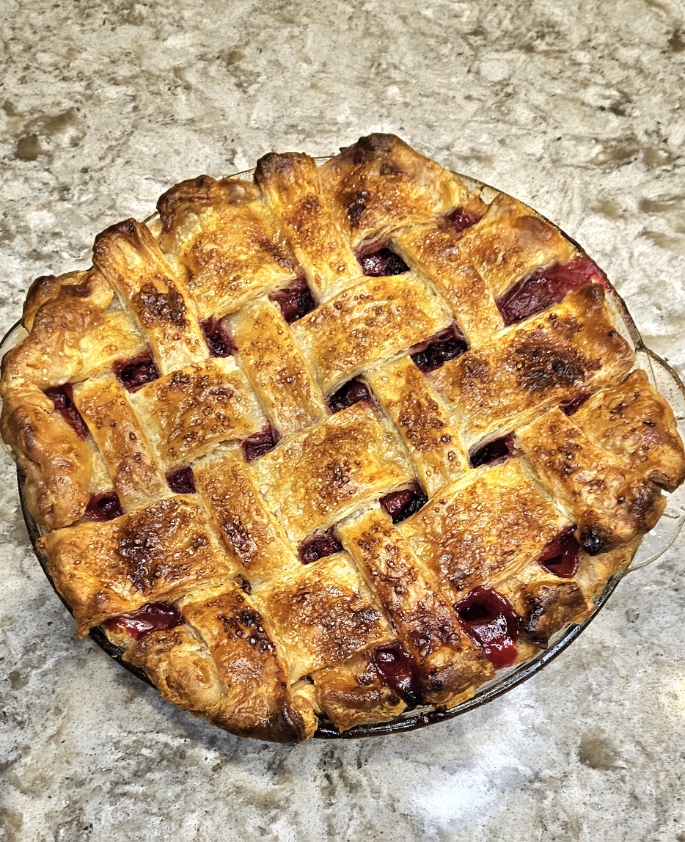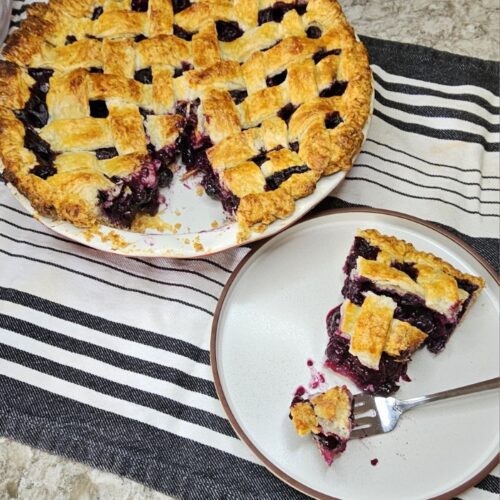Flakiest Pie Crust

UPDATED:
This pie crust recipe is the ultimate in flakiness. The crust boasts a buttery, delectable flavor with delicate, airy layers. It’s tender yet crisp, offering an ideal counterpoint to any filling it holds. Whether it’s a sweet blueberry pie or a savory chicken pot pie, this flaky, buttery crust turns each bite into a luxurious treat that will have you longing for more.
To be completely candid, making pie crusts has always been my weak spot. I would meticulously follow a recipe only to end up with disappointing results. However, I continued to learn more about how to make the flakiest of pie crust so that I could share with you some tips and tricks that I learned. Continue reading to learn what I learned.
What I’ve learned about making a great pie crust:
While my crust came out ok, I still had some hiccups when it came to making A great pie crust. I couldn’t figure out why my dough was still crumbly when I went to roll it out. I discovered through more research; I needed to add more water than what the recipe called for. I’ve listed a few other important steps below.
Cold ingredients:
Although I had previously overlooked the emphasis on cold ingredients in this recipe, I realized its significance after my crusts turned out flat and tough. The key takeaway is to use extremely cold butter, shortening, and water. Additionally, chilling the flour in the refrigerator for about 15 minutes can be advantageous, especially if your home is very humid and warm.
Overworking the dough is a no-no!
The second lesson I learned is the butter and/or shortening needs to be worked into a course meal with some pea-sized chunks remaining. It’s these cold bits of fat that give the pastry its flakiness. UPDATE: After making a number of pies during the holidays I figured something that out that helped me out a ton and it will help you as well. And here it is: Cut the butter into the flour as if you’re touching every piece of flour. Those bits of butter when done need to be as mentioned pea-sized at they’re largest, but a lot of the butter will be smaller. It’s extremely important to work that butter into the flour to get a course meal. Then when adding water, it won’t feel like you need to keep adding more to get a cohesive dough.
The right amount of water? You may need more; you may need less (depends on the dryness of the air. A dryer environment you may need more but in a more humid environment you may need less.
Finally, the crucial aspect for me is water management. Make sure not to add too much or too little water. The goal is to form the dough into a ball with ease, without overworking it. Too wet and sticky? You’ve added too much. But you can remedy this by sprinkling in a bit more flour until it’s no longer sticky. If it’s too crumbly and difficult to shape into a ball, it needs more water. But if you got that butter cut well into the flour this shouldn’t happen. However, if this happens, moisten your fingers and gently work the water into the dough until it’s pliable but not sticky. It’s a delicate balance, but as you gain experience making pie crusts, achieving the right consistency becomes easier. In reality, a good pie crust is more technique than it is a recipe.
Below is a picture of what the dough should look like. You can see the big bits of butter/shortening and it has the right amount of water (because if it didn’t it would be dusty looking).

Since doing my research and practicing a lot, I’ve had great success making blueberry, cherry, peach, apple, mixed berry, as well as chicken pot pie. I haven’t documented all of them on my blog yet, but here is the link to my blueberry pie recipe Delicious Blueberry Pie – The culinary dabbler that uses this perfectly flaky pie crust recipe. Ever since I perfected my pie crust, which turns out great every time, I seize every opportunity to make pie. I hope you do too.
Note: This recipe calls for both butter and shortening; shortening is more manageable, so it’s recommended if new to pie-making to start with a blend of both. As you become more comfortable, you can transition to an all-butter crust. In the recipe below, I’ve listed the precise measurements for each variation.
The specific pie recipe instructions are provided below. I hope this was useful. Please leave a comment and let me know you tried it out!

Flakiest Pie Crust
Equipment
- Deep Dish Pie Plate
Ingredients
Flakiest Pie Crust
- 2 1/2 cups Flour
- 1 tsp salt
- 1/2 cup very cold water (add ice to get the water very cold) and then measure out to 1/2 cup.
Combination butter and shortening option:
- 6 tbsp butter, very cold and cubed
- 2/3 cup shortening, very cold and cubed
All butter option:
- 2 tsp granulated sugar
- 1 cup unsalted butter, very cold and cubed
Instructions
- Mix the flour and salt together in a large bowl.
- Add cubed butter and shortening to the bowl. Toss the fat in the flour to cover completely. I like to use a pastry cutter initially and run it through the mixture to help start to break down the fats. Then using your fingers break down the butter and shortening into the flour resembling pea-sized chunks, leaving some bigger chunks (about walnut-sized). Be sure not to over work the fat into the mixture. You want those pea-sized and bigger chunks. If your dough gets too warm through it back in the fridge for about 20 minutes. You want it very cold.
- Measure out the water to a half of a cup.
- Make a well in flour and fat mixture and pour the water into the middle. Using your hands toss the flour and fat a few times to distribute the water. Then start pressing the dough together until it clumps and can be formed into a ball. If there is enough water you should be able to do this easily, if not add additional water, a tablespoon at a time until the dough starts to clump together. Often, I have had to add more than the recipe calls for. But it does depend on your environment. Add just enough to make the dough clump together. Too much will make the dough sticky and too little will make a crumbly dough and won't come together easily into a ball.
- Turn the dough onto the counter and mush the dough together into a big disk. Cut the disk in half and wrap each in plastic wrap. Flatten each piece into disks. This will help with the rolling process.
- Place in refrigerator for at least 2 hours or up to 3 days. *You can freeze the dough for up to 3 months. Wrap it in plastic wrap and again in foil before freezing. When you're ready to use, thaw overnight in the fridge and you're ready to roll it out the next day.
- Once the dough has chilled for a least 2 hours, you are ready to roll out your dough. Refer to specific pie recipe for further instructions on rolling out dough.
